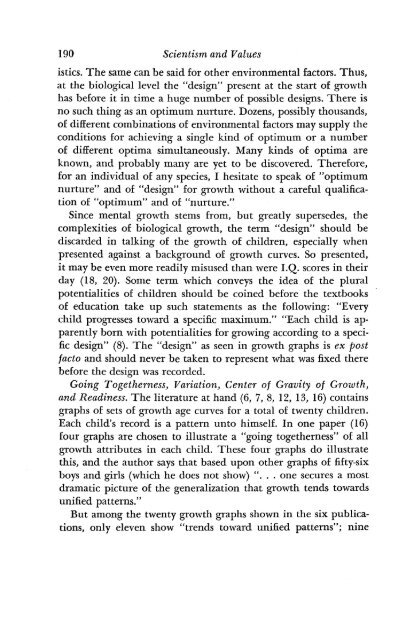Scientism and Values.pdf - Ludwig von Mises Institute
Scientism and Values.pdf - Ludwig von Mises Institute
Scientism and Values.pdf - Ludwig von Mises Institute
You also want an ePaper? Increase the reach of your titles
YUMPU automatically turns print PDFs into web optimized ePapers that Google loves.
190 <strong>Scientism</strong> <strong>and</strong> <strong>Values</strong><br />
istics. The same can be said for other environmental factors. Thus,<br />
at the biological level the "design" present at the start of growth<br />
has before it in time a huge number of possible designs. There is<br />
no such thing as an optimum nurture. Dozens, possibly thous<strong>and</strong>s,<br />
of different combinations of environmental factors may supply the<br />
conditions for achieving a single kind of optimum or a number<br />
of different optima simultaneously. Many kinds of optima are<br />
known, <strong>and</strong> probably many are yet to be discovered. Therefore,<br />
for an individual of any species, I hesitate to speak of "optimum<br />
nurture" <strong>and</strong> of "design" for growth without a careful qualific.ation<br />
of "optimum" <strong>and</strong> of "nurture."<br />
Since mental growth stems from, but greatly supersedes, the<br />
complexities of biological growth, the term "design" should be<br />
discarded in talking of the growth of children, especially when<br />
presented against a background of growth curves. So presented,<br />
it may be even more readily misused than were I.Q. scores in their<br />
day (18, 20). Som.e term which conveys the idea of the plural<br />
potentialities of children should be coined before the textbooks<br />
of education take up such statements as the following: "Every<br />
child progresses toward a specific maximum." "Each child is apparently<br />
born with potentialities for growing according to a specific<br />
design" (8). The "design" as seen in growth graphs is ex post<br />
facto <strong>and</strong> should never be taken to represent what was fixed there<br />
before the design was recorded.<br />
Going Togetherness) Variation) Center of Gravity of Growth)<br />
<strong>and</strong> Readiness. The literature at h<strong>and</strong> (6, 7, 8, 12, 13, 16) contains<br />
graphs of sets of growth age curves for a total of twenty children.<br />
Each child's record is a pattern unto himself. In one paper (16)<br />
four graphs are chosen to illustrate a "going togetherness" of all<br />
growth attributes in each child. These four graphs do illustrate<br />
this, <strong>and</strong> the author says that based upon other graphs of fifty-six<br />
boys <strong>and</strong> girls (which he does not show) "... one secures a most<br />
dramatic picture of the generalization that growth tends towards<br />
unified patterns."<br />
But among the twenty growth graphs shown in the six publications,<br />
only eleven show "trends toward unified patterns"; nine
















